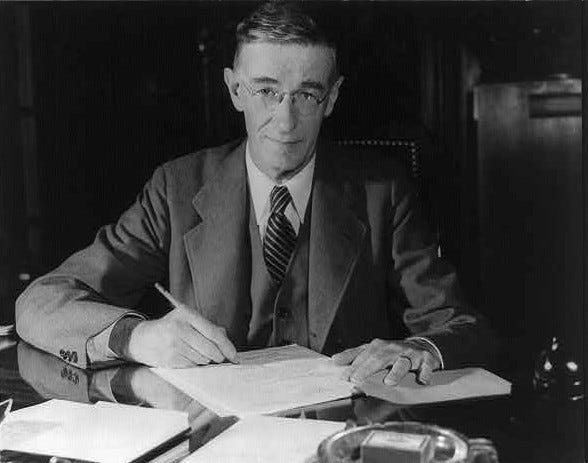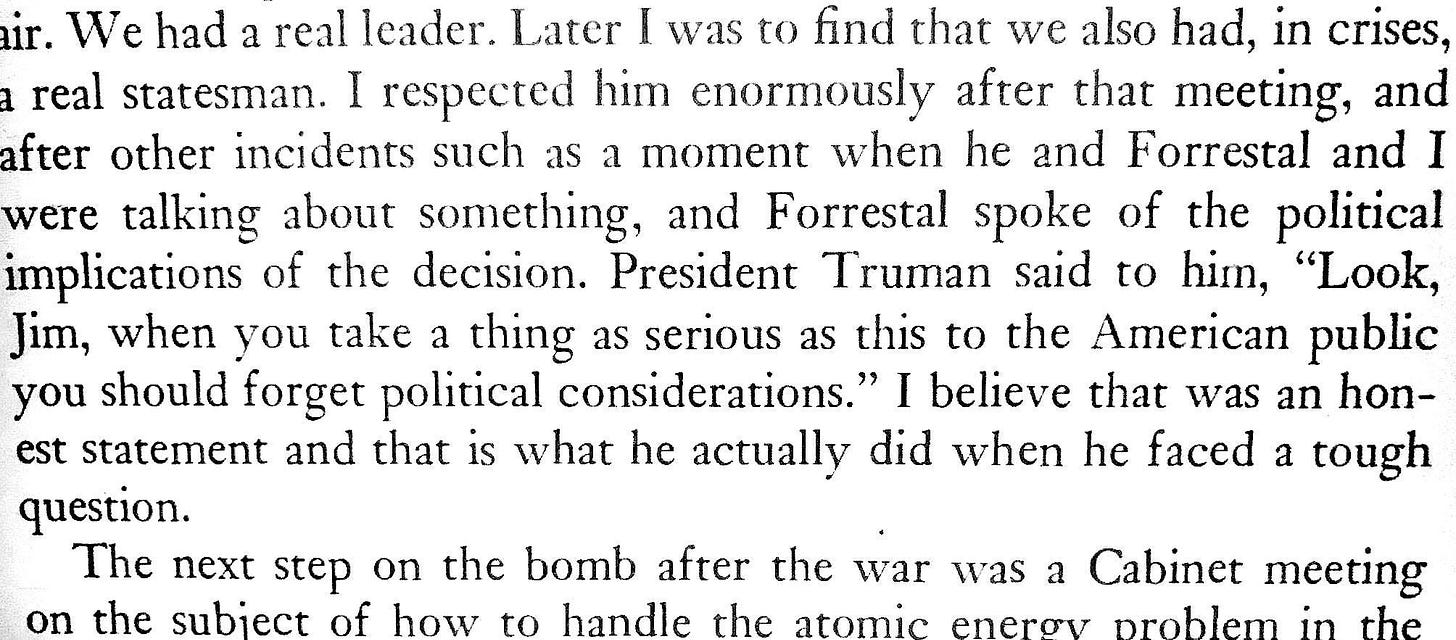[This article’s content is free of any AI contribution]

This week opened with strong mainstream media coverage of the UAP topic by Last Week Tonight. I felt the piece did a good job of catching up the audience on the history of the UFO topic as seen from a “narrative-safe” bystanders’ perspective. But as TheHill’s intrepid journalist Marik von Rennenkampff highlights, the piece ignored crash retrievals, reverse engineering, and by extension Grusch’s testimony. In other words, what everyone calls The Program. Message: Discuss old UAP sightings as you will, but full-throated discussion evaluating the existence of The Program is The Bridge That Shall Not Be Crossed.
Longtime readers will know that my vector for prying open the proverbial doors of The Program proceeds by way of history. I’ve covered on Twitter/X that the UAP transparency movement can achieve a tactical win by focusing on supporting (or invalidating) whether famed* WWII innovation chief Vannevar Bush exercised executive scope in The Program’s early incarnation. More on that strategy at the end of this article. Rather, to start with, readers will want to know where the evidence base stands with regards to Vannevar Bush’s involvement in the early years of The Program. Since my last article on Vannevar, I’ve assembled additional evidence from the pages of famous UFO researchers’ works from the 1980s. Let’s examine that state-of-play.

Like a common wooden table, the evidence of Vannevar’s involvement stands on four legs. And like that four-legged table, any single leg can be kicked out from under it, and the table will remain standing (if just barely!). This piece isn’t intended to be a critical look at any of the legs (stay tuned for that! I indeed have some quibbles & counterarguments for each of these legs :) ), it’s an uncritical description of where things stand for the purposes of bringing everyone onto the same page for follow-on discussion.
1. From “first principles”
Vannevar Bush headed the OSRD (Office of Scientific Research & Development) during WWII, an office operating through extraordinary organizational leverage to generate such technological accomplishments as the proximity fuze, radar, anti-submarine tech, and yes, the atomic bomb itself by way of the storied Manhattan Project. The OSRD actively winds down after the war, and Vannevar creates the JRDB (‘Joint Research & Development Board’) to fill a similar peacetime role in the OSRD’s place. The JRDB becomes the RDB (‘Research & Development Board’) with the 1947 National Security Act. The RDB exists in that form over four board chairmanships, (and under two presidential administrations) into the late 1950s, before getting subsumed more fully into the Department of Defense.
In engineering parlance, “first principles” means assessing an assertion (more explicitly, envisioning an engineering product or exploit) starting from a point of fundamental, universally accepted axioms requiring no further assumptions to frame (and therefore risk confusing) the matter at hand.
2. Sarbacher’s mentions:
(Robert Sarbacher, the scientist who Grusch strongly namechecked during his American Alchemy interview)
UFO researchers Stanton Friedman (‘SFriedman’) and Timothy Good ('TGood’) writing in the 1980s in Crash at Corona¹ (‘CaC’) and Above Top Secret² (‘ATS’), respectively, assembled the very emphatic mentions of Vannevar Bush on the part of accomplished Scientist-Engineer for the AEC & DoD Robert Sarbacher, starting in 1950 and repeated in 1983:
Robert Sarbacher mentioning Vannevar Bush timeline:
12 Sep 1950 - Canadian government-affiliated engineer Wilbert B. Smith meeting/interview with Dr. Robert Sarbacher. -“Notes on interview through Lt/C. Bremner with Dr. Robert Sarbacher”
-(reportedly handwritten note) transcribed & dated via CaC15 Sep 1950 - Date of Wilbert B. Smith’s handwritten notes on the ‘interview’ with Sarbacher -ATS
21 Nov 1950 - Wilbert B. Smith writes memo for the Canadian Government Department of Transport, Controller of Telecommunications describing “discreet inquiries” made via the Canadian Embassy in Washington DC ,
“1. The matter is the most highly classified subject in the United States Government, rating even higher than the H-bomb. 2. Flying saucers exist. 3. Their modus operandi is unknown but concentrated effort is being made by a small group headed by Doctor Vannevar Bush. 4. …”-CaC, ATS; (TGood attributes source as Sarbacher in ATS)
_ ___ 1978 - Canadian UFO researcher Arthur Bray receives Smith memo from Canadian government, subsequently tracks down Smith’s handwritten note. -CaC
_ ___ 1979 - SFriedman is shown Smith’s 21-Nov 1950 memo by Canadian investigator Scott Foster. -CaC
14 Oct 1983 - William Steinman writes inquiries to Robert Sarbacher. -ATS
29 Nov 1983 - Written response to William Steinman, under letterhead “Washington Institute of Technology, Oceanographic and Physical Sciences, Dr. Robert L. Sarbacher, President and Chairman of Board”
“Dr. Vannevar Bush was definitely involved,..” -ATS5 Dec 1983 - William Steinman records having received response from Sarbacher. -ATS
_ Dec 1983 - SFriedman calls Sarbacher. “assured that much of the information reported by Steinman was accurate” -CaC
_ ___ 1983 - “Sarbacher told SFriedman in a face-to-face meeting in 1983 that there could have been several crashes …” -CaC
3. Earliest Majestic docs
The set of document leaks collectively termed as the “Majestic documents”, starting from the initial drop in 1984, make frequent reference to Vannevar Bush’s directorship capacity in The Program’s operations. The basic contents of the earliest drop, to Jaime Shandera in Southern California, was recounted by Stanton Friedman in “Crash at Corona”, “Top Secret/MAJIC”, and by Timothy Good in “Above Top Secret”.
For purposes of ease-of-access, of electronic files I can find easily on the Woods’ MajesticDocuments.com website, the one that is most representative and relevant to the discussion at hand is the Eisenhower briefing, particularly 1. its copy of the Sep 24th 1947 memo and 2. its columnar listing of the 12 members. I treat Stanton Friedman’s book Top-Secret/MAJIC as an authoritative description of the documents in the initial Majestic drop to Shandera, while understanding that the more photorealistic renderings of the documents may be located among the Woods’ publications.
4. Pieces of the Action:
(a highlight from which was my recent, small contribution to UAP research)
Whatever his well-documented foibles & flaws (technocratic elitism, imperiousness, preferring operating in secrecy), the version of Vannevar Bush’s character I am more familiar with is of someone who deeply, fundamentally, wants everyone who is capable to be educated in the technical sciences or engineering. With that in mind, I thought that as someone who on a first-principles basis was involved in The Program (as well as suggested by the Majestic docs - I hadn’t read the Sarbacher mentions yet), he would want people to have some clue about UAP reality stemming from his scope on The Phenomenon. In his 1970 quasi-autobiography, Pieces of the Action³, Vannevar quotes Truman during one of the few meetings in which he shares the president’s attention with Secretary of Defense James Forrestal. He says, providing no other context besides that of a ‘crisis’ or ‘incident’:
“We had a real leader. Later I was to find that we also had, in crises, a real statesman. I respected him enormously after that meeting, and after other incidents such as a moment when he and Forrestal and I were talking about something, and Forrestal spoke of the political implications of the decision. President Truman said to him, “Look, Jim, when you take a thing as serious as this to the American public you should forget political considerations.” I believe that was an honest statement and that is what he actually did when he faced a tough question.”Reminding that the article you are reading here is an uncritical assembly of the evidence, my following interpretation of the quote is in the ufology context:
An engagement of some kind with the phenomenon has recently occurred (The Kenneth Arnold-initiated UFO sighting flap coupled with the Roswell crash (and any associated crashes)). In that context, Forrestal is querying President Truman whether they ought to go public with the verified existence of NHI, exploring political implications (re-election prospects and the like) of same. Truman seems to think it will disturb the public consciousness so much that political implications will be so overshadowed as to be rendered irrelevant The main issue will be that the public suffers a philosophical existential crisis as to humanity’s place in the universe, with all the social upheaval Truman believes that will entail.

————-
Disclosure-eliciting Tack
As I opened this article with, there is a practical benefit to focusing on supporting (or invalidating) Vannevar Bush executive scope in The Program’s early incarnations. Credibly fingering Vannevar can lead to one particularly desirable tactical outcome. The present-day Department of Energy (DoE), which used to be the Atomic Energy Commission, and which was the Manhattan Engineering District during WWII (the ‘Manhattan Project’) collectively knows very very well it owes its very existence to the efforts of Vannevar Bush. By all accounts, it was his work in advocating for and commissioning atomic fission studies under the NRDC / OSRD that led to the underlying progress demonstrating the feasibility of atomic bomb research.
Also, in the infamous AEC security hearing for, J Robert Oppenheimer, the father of the MP→AEC→DoE, Vannevar vigorously† defended ‘Oppie’. for 50 minutes straight⁴. In the wake of which, Vannevar vocally vented to Newsweek, “Our internal security system has run wild”⁴. Alongside his own opposition to the H-bomb’s development that he shared with Oppenheimer, and increasing friction with military R&D, such a vocal response to the AEC’s toxic security climate probably contributed to his star falling through the Eisenhower years till he left Washington D.C. for good.
It’s a historical irony (or poetic justice, depending on your perspective) that the very military-industrial R&D complex that Vannevar midwifed into existence became the agent for his own marginalization. If Vannevar did have executive scope on The Program, the arc of his participation probably mirrored the above.
So your average DoE scientist-engineer probably feels a lot of kinship with Vannevar. Meanwhile, for all the sporadic leaks and whistleblowers we’ve benefited from over the years - pilots, intel people, military - we haven’t had leaks from the DoE - whose unique security apparatus Grusch asserts (and Karl Nell implies) was used to house much of UAP secrecy. The closest we got was Bob L, and we know how much his provenance has been questioned.
Engineers & scientists working inside the present-day DoE…
…have access to records that most people don’t,
…can look at a clear tying of Vannevar Bush to the UAP topic,
…recognize the scope of VB’s legacy on their own work,
…consider that maybe the technologies they are developing or at least have unreleased archive access to, may be more attributable to appropriated technologies of unknown origin (TUO) rather than de novo human innovations
…recognize that Vannevar Bush may have intended to leak basic confirmation about the reality of UAP / NHI via his autobiography (Evidence #4 above).
From that point, a sympathetic engineer/scientist can choose to act in whatever way they will with that knowledge - for example, they can pursue declassification channels, produce leads for FOIAing (more than these is up to their own conscience, i.e. I can’t encourage..), or perhaps take no action at all. Will they follow Vannevar’s demonstrated example in #4 above and strive to get information out into the light of day? Or will they continue to “play ball” and keep the secrets on lock over umpteen more future generations? Either way, the scope for exercising agency will have arrived into the hands of a very different, much more widespread milieu (consider how many engineers/scientists work for the DoE) than a very tight close-knit present day UAP control group hell-bent on keeping the information airtight.
This empowerment scenario is why I believe supporting the veracity of Vannevar Bush’s involvement will pose a very big win for UAP transparency. Even invalidating, will not only save us a lot of trouble, but also add impetus to finding out how or by who his research-organizing role got provisioned.
This is where you, the reader, come in. The DoE employs over 50,000 people, a large proportion of whom are scientists & engineers whose daily bread-and-butter is a product of Vannevar’s legacy. You probably know someone who knows someone who works for them. I entreat you to send this article to someone you know who operates in DoE circles. If you don’t know such people, send to technical people you know, and let them proceed from there. And in keeping with Grusch’s example, everything suggested is in perfect legality.
This article is far from the last word on Vannevar’s association with The Program. In future articles, we’ll dissect each of the four pieces of evidence #1-4 above. We’ll examine the balance of evidence for and against each leg of the table. It’s sure to be a wild ride, so for you (and your contacts you send this article to) we’ll make sure it’s a fun dive into evaluating this key interval in postwar UAP history.
Closing anecdote
I close with an anecdote that demonstrates by way of example. Before he became a media-citable UAP researcher, Stanton Friedman was a nuclear physicist for energy & defense contractors. That means his work necessarily operated at the periphery of DoE scope (secrecy & security of nuclear materials). He probably rubbed shoulders with a fair number of DoE scientists firsthand. Speculatively, those relationships may have informed his UAP research. Not at all speculatively, he was invited by Los Alamos National Lab to speak on crashed saucers in New Mexico.
Consider how far Stanton Friedman carried the UAP topic. The fact that we talk about Roswell with a significant degree of confidence is largely thanks to his efforts. And do you know what? Who inspired him? Among other sources, we know that despite all of The Program covering-up, Vannevar Bush was actually one of Stanton’s heroes. So think of the power that one man’s legacy, viewed through the right socio-cultural lens, has to transform the collective conversation.
* famed sufficiently to be portrayed in Christopher Nolan’s 2023 blockbuster biopic Oppenheimer
† and portrayed in this scene from Oppenheimer (possibly cut from feature film) portrayed by actor Matthew Modine.
Bibliography
Friedman, S., & Berliner, D.; “Crash at Corona”. Paragon House, 1992
Good, T. “Above Top Secret”, Quill William Morrow, 1988
Bush, V. “Pieces of the Action”, William Morrow, 1970, p.295
Zachary G. “Endless Frontier: Vannevar Bush, Engineer of the American Century”. Ch 15 New York: The Free Press; 1997 .



